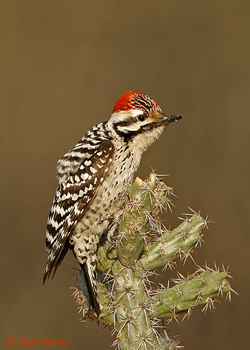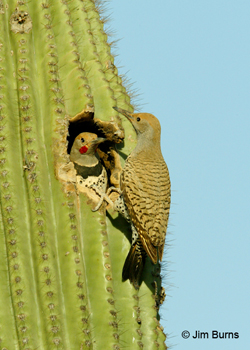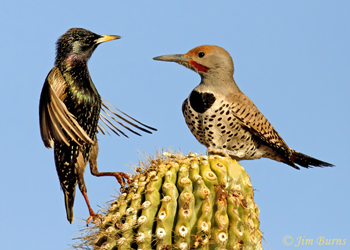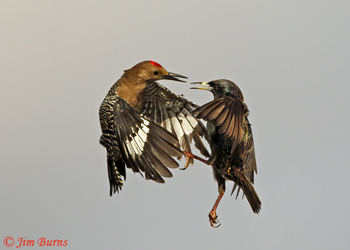Ladder-backed Woodpecker male on Chain-fruit Cholla Cactus |
Gilded Flicker pair at home in Saguaro Cactus |
The dearth of available saguaros and the multitude of starlings seem to have a direct impact on the numbers and activity of our native desert woodpecker species at my patch. The smallest, the Ladder-backed, ironically enough known as the “Cactus Woodpecker” back in the day, is the one I see the least, perhaps only a few times in a year, and I have never found a nest in the park. Ladder-backeds are known to use saguaro nests in Mexico, but in Arizona not so much. Here nests are found primarily in paloverde, mesquite, and willow, occasionally in hackberry, cholla, and old fence posts. Ladder-backeds are 7¼ inches.
The largest, the Gilded Flicker, is represented by three different pairs with distinct territories, all nesting in saguaros with almost no starling interaction. Recently, as I watched one of my Gilded males calling and drumming from atop a saguaro, a starling swooped in and landed across from him on the opposite side of the cactus top, about six inches from the flicker, face to face. The woodpecker never moved, flinched, or even blinked. The starling stretched up tall, but the flicker just looked amused, the starling backed down and flew away. Gildeds are 11½ inches.
Gila Woodpeckers are a lot more common in my patch than the shy and retiring Ladder-backeds and the quieter, more laid back flickers. Gilas are louder to the point of being obstreperous, flighty and nervous, constantly on some mission, always back and forth from here to there. And often in negotiations with the starlings. Almost daily as the desert winter slips into breeding season, I see Gilas and starlings at one another, wings and feathers flying, knocking one another off perches, pairs escorting singles away from saguaros, and even actual aerial battles, knives drawn, eyes protected by drawn nictitating membranes. Gilas are 9½ inches, starlings 8½.
The pattern I’ve observed, as you might guess, is that Ladder-backeds do not mess with the larger European Starlings, and the latter don’t mess with the larger Gilded Flickers. So, it seems anything over an inch is a size differential large enough to matter in the avian world, but one inch is not, and three inches is huge. It is a known fact that Gila Woodpeckers, conspicuous, brash, and noisy lead singers in the desert dawn chorus, are in decline. Habitat degradation is one factor, but a larger one is that they are being outcompeted for nesting sites by the invasive starlings which are, much like the also ubiquitous American Coots, querulous, irascible, and combative on territory.
It is unfortunate that the preferred location for Gila nest excavation is the Saguaro Cactus because the cavities they build in these apartment complexes are also the preferred size for the starlings and apparently perfectly suitable for these invaders. In these cacti, where the plant’s fiber is soft and vascular to facilitate water storage, the fleshy tissue exposed by the Gilas’ digging secretes a fluid that hardens to create a scabrous lining on the inside of the cavity. These are the cactus “boots” often found on the desert floor near fallen saguaros.
Boot is what European Starlings often do to Gila Woodpeckers at their nesting sites, and I’ve assumed there are no Ladder-backed nests at all because this smallest of our three desert woodpeckers just cannot compete with the starlings. In addition to their many other unendearing traits, European Starlings apparently are lazy and only too happy to have Gilas do the work of cavity building for them. I have no compunction attributing human character deficiencies to European Starlings, and I’m rooting for our Gila Woodpeckers in every battle I see.
Gilded Flicker male face-off with European Starling |
Gila Woodpecker negotiations with European Starling |



